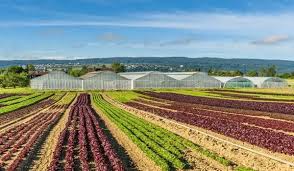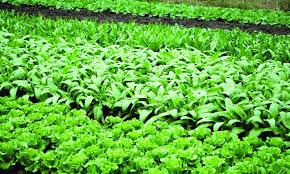Crop Diversification Systems refer to the practice of cultivating a variety of crops within a single farming system. This approach enhances agricultural productivity, resilience, and sustainability.
As global food demand continues to rise, driven by population growth and changing dietary preferences, the need for efficient and sustainable farming practices becomes increasingly vital.
Crop diversification not only maximizes land use but also mitigates risks associated with monoculture, where reliance on a single crop can lead to vulnerability from pests, diseases, and market fluctuations.
By integrating diverse crops, farmers can create a balanced ecosystem that supports soil health, increases biodiversity, and improves the overall resilience of the agricultural system.
One of the primary benefits of crop diversification is improved soil health. Different crops have varying root structures, nutrient requirements, and pest management strategies, which can enhance soil fertility and structure. For example, legumes, such as beans and peas, fix nitrogen in the soil, benefiting subsequent crops.
This natural process reduces the need for synthetic fertilizers, promoting a more sustainable farming practice. Additionally, crop rotation helps in breaking pest and disease cycles, ultimately leading to healthier crops and higher yields over time.
Economic stability is another significant advantage of crop diversification systems. By growing multiple crops, farmers can spread their income sources and reduce their dependency on a single crop. This financial safety net is crucial, especially in regions where crop prices can be volatile due to market trends or climate conditions.
Diversified farming systems allow farmers to take advantage of different market demands and ensure a more stable income throughout the year. For instance, if one crop suffers due to a pest outbreak or adverse weather, other crops can still yield returns, providing a buffer against economic losses.
Furthermore, crop diversification enhances biodiversity, which plays a critical role in ecosystem health. Diverse cropping systems support a variety of beneficial insects, pollinators, and microorganisms that contribute to a robust agricultural environment. These interactions can lead to improved pest control, reduced reliance on chemical pesticides, and healthier crops overall.
By fostering a rich biodiversity, farmers can create resilient systems capable of withstanding environmental stressors, such as climate change and extreme weather events.
In addition to environmental and economic benefits, crop diversification systems can improve food security and nutrition. By cultivating a range of crops, farmers can produce various food types that contribute to a balanced diet. This is particularly important in regions facing malnutrition, as diverse crops can provide essential vitamins and minerals that may be lacking in staple foods.
Promoting the growth of underutilized crops, such as millet, quinoa, or traditional vegetables, can also enhance local diets and cultural practices, making agriculture more inclusive and community-focused.
Moreover, crop diversification systems can be beneficial in promoting sustainable agricultural practices. They align with the principles of agroecology, which emphasizes the importance of ecological processes in farming.
By adopting practices like intercropping, cover cropping, and agroforestry, farmers can enhance soil and water conservation, reduce greenhouse gas emissions, and improve resilience to climate change impacts.
This approach supports the broader goals of sustainable development by promoting environmentally friendly practices that contribute to long-term agricultural viability.
Crop Diversification Systems offer numerous benefits that can transform agricultural practices, improve farmer livelihoods, and enhance food security. Through promoting soil health, economic stability, biodiversity, nutrition, and sustainability, this approach represents a forward-thinking solution to the challenges facing modern agriculture.
Embracing crop diversification can help ensure that farming remains viable and productive in the face of changing environmental and economic conditions, ultimately contributing to a more resilient food system.
Enhancing Soil Health through Diversification

1. Crop Rotation: Rotating different crops in a field each season prevents nutrient depletion and reduces the buildup of pests and diseases. Diverse root structures also improve soil structure and enhance microbial diversity.
2. Cover Cropping: Planting cover crops such as clover or rye during off-seasons protects the soil from erosion, improves soil organic matter, and enhances nutrient cycling. These crops also suppress weeds and improve soil fertility.
3. Agroforestry: Integrating trees into agricultural landscapes can enhance soil health by promoting biodiversity, improving soil structure, and increasing organic matter through leaf litter and root biomass.
4. Intercropping: Growing different crops in proximity can enhance nutrient uptake, improve soil moisture retention, and reduce the risk of total crop failure due to pests or diseases targeting a single crop.
5. Reduced Tillage: Minimizing soil disturbance through reduced tillage practices preserves soil structure, enhances moisture retention, and increases organic matter, leading to improved soil health over time.
Improving Pest and Disease Management
1. Integrated Pest Management (IPM): Combining biological control, cultural practices, and chemical methods helps manage pest populations effectively while minimizing environmental impact and chemical usage.
2. Companion Planting: Planting certain crops together can deter pests and enhance crop health. For example, marigolds can repel nematodes, while basil can enhance the flavor and growth of tomatoes.
3. Monitoring and Scouting: Regularly inspecting crops for signs of pest and disease allows for early intervention. Utilizing technology, such as drones and sensors, can enhance scouting efficiency and accuracy.
4. Resistant Varieties: Planting disease-resistant crop varieties reduces the likelihood of outbreaks. Breeding programs focus on developing crops that can withstand specific pests and diseases, improving overall farm resilience.
5. Soil Health Practices: Healthy soils promote strong plants, which are more resistant to pests and diseases. Practices like adding organic matter and maintaining proper pH levels support plant health and vigor.
Read Also: Find out What a Brooder House is
Increasing Crop Resilience to Climate Change

1. Drought-Resistant Varieties: Selecting and cultivating drought-resistant crop varieties can enhance resilience to changing rainfall patterns, ensuring stable yields under water-scarce conditions.
2. Adaptive Crop Management: Implementing adaptive management strategies based on weather forecasts and climate projections helps farmers make informed decisions about planting dates, crop choices, and resource allocations.
3. Soil Conservation Techniques: Practices such as contour farming, terracing, and creating buffer zones help prevent soil erosion, retain moisture, and improve soil structure, thereby enhancing crop resilience.
4. Diversified Farming Systems: Employing a mix of crops and livestock creates a more resilient agricultural system. This diversity can buffer against market fluctuations, pest outbreaks, and changing climate conditions.
5. Water Management Strategies: Implementing efficient irrigation systems, such as drip irrigation and rainwater harvesting, can optimize water usage and improve crop resilience in the face of variable weather patterns.
Boosting Farm Income and Reducing Financial Risk
1. Diversification of Crops and Livestock: Growing a variety of crops and raising different livestock can reduce dependence on a single source of income, providing financial stability even if one crop fails or market prices drop.
2. Value-Added Products: Processing raw agricultural products into value-added goods, such as turning fruits into jams or grains into flours, can significantly increase profits and provide more options for market sales.
3. Direct Marketing Strategies: Selling directly to consumers through farmers’ markets, Community Supported Agriculture (CSA) programs, or online platforms can eliminate intermediaries, ensuring higher prices for farmers.
4. Crop Insurance: Investing in crop insurance can mitigate financial risk associated with natural disasters, crop failure, or market fluctuations, providing a safety net that protects farm income.
5. Sustainable Practices for Cost Reduction: Implementing sustainable agricultural practices can reduce input costs over time. For example, using cover crops can improve soil health and decrease the need for synthetic fertilizers.
Enhancing Biodiversity on Farms
1. Agroecological Practices: Adopting agroecological methods that emphasize biodiversity, such as intercropping and cover cropping, can create a balanced ecosystem that supports pest control and soil health.
2. Wildlife Habitat Preservation: Creating habitats for beneficial insects and wildlife on farms helps promote natural pest control and supports pollinator populations, which are essential for many crops.
3. Seed Diversity: Planting a variety of crop species and heirloom varieties can enhance resilience to pests and diseases while also providing diverse harvests that cater to different markets.
4. Sustainable Livestock Grazing: Rotational grazing practices can promote soil health and improve biodiversity, allowing pastureland to regenerate and supporting various plant and animal species.
5. Organic Farming Practices: Transitioning to organic farming enhances biodiversity by avoiding synthetic chemicals, which can harm beneficial organisms and degrade ecosystem health.
Improving Nutritional Security for Communities
1. Local Food Systems: Promoting local food production and consumption increases access to fresh, nutritious foods within communities, improving overall dietary quality and health outcomes.
2. Community Gardens: Establishing community gardens can enhance food security by providing space for residents to grow their own fruits and vegetables, fostering community engagement and education.
3. Nutritional Education Programs: Implementing programs that educate communities about nutrition, cooking, and food preservation can empower individuals to make healthier food choices and utilize local resources effectively.
4. Supporting Smallholder Farmers: Assisting smallholder farmers with resources, training, and market access can improve local food production, enhancing community resilience and nutrition.
5. Crop Diversification for Nutritional Value: Growing a diverse range of crops can improve the nutritional content available to communities, ensuring access to essential vitamins and minerals.
Optimizing Resource Use Efficiency
1. Precision Agriculture Technologies: Implementing precision agriculture tools, such as GPS and sensors, can optimize resource use by providing data-driven insights into soil health, moisture levels, and crop needs.
2. Efficient Water Management: Utilizing techniques like drip irrigation and rainwater harvesting can significantly reduce water usage, ensuring efficient resource use and improving crop yields.
3. Nutrient Management Plans: Developing comprehensive nutrient management plans that use soil testing to determine specific nutrient needs can enhance fertilizer efficiency, reduce waste, and lower costs.
4. Renewable Energy Adoption: Integrating renewable energy sources, such as solar or wind power, can decrease reliance on fossil fuels, reduce operational costs, and promote sustainability on farms.
5. Waste Reduction and Recycling: Implementing waste reduction strategies, such as composting crop residues or recycling water, can enhance resource use efficiency while contributing to soil health and environmental sustainability.
Read Also: 12 Medicinal Health Benefits Of Betula lenta (Sweet birch)
Expanding Market Opportunities for Farmers

1. Direct-to-Consumer Sales: Farmers can enhance profitability by selling products directly to consumers through farmers’ markets, online platforms, or subscription boxes, which can eliminate intermediaries and allow for better pricing.
2. Specialty Crop Production: Growing specialty or niche crops, such as organic produce, exotic fruits, or heirloom vegetables, can tap into lucrative markets that cater to health-conscious or gourmet consumers, expanding market reach.
3. Value-Added Products: Developing value-added products, such as jams, sauces, or packaged meals, allows farmers to diversify their income streams and capture more value from their raw products.
4. Collaborations and Cooperatives: Forming cooperatives with other farmers can enhance market access, reduce costs, and improve bargaining power when negotiating prices with distributors and retailers.
5. Agritourism: Offering agritourism experiences, such as farm tours, pick-your-own produce events, or educational workshops, can attract visitors, create additional revenue streams, and promote farm products.
Strengthening Agricultural Sustainability
1. Sustainable Farming Practices: Implementing practices such as crop rotation, cover cropping, and reduced tillage can improve soil health, enhance biodiversity, and increase resilience to climate change.
2. Integrated Pest Management (IPM): Utilizing IPM strategies minimizes chemical use and promotes the natural control of pests through biological and cultural practices, enhancing ecosystem health while maintaining crop yields.
3. Soil Conservation Techniques: Adopting soil conservation practices, such as contour farming and agroforestry, can prevent soil erosion, enhance nutrient retention, and promote long-term agricultural viability.
4. Water Conservation Strategies: Implementing efficient irrigation systems, rainwater harvesting, and moisture-retentive practices can conserve water resources and improve overall water management on farms.
5. Education and Training: Providing farmers with education and training on sustainable practices can empower them to adopt more environmentally friendly methods, contributing to long-term agricultural sustainability.
Promoting Ecosystem Services and Environmental Health
1. Biodiversity Enhancement: Encouraging biodiversity on farms through diverse cropping systems, agroforestry, and wildlife habitat conservation helps maintain ecosystem balance, supporting beneficial organisms that enhance productivity.
2. Carbon Sequestration Practices: Implementing practices that sequester carbon, such as reforestation, cover cropping, and no-till farming, can mitigate climate change impacts and improve soil health.
3. Water Quality Protection: Adopting practices that prevent runoff and protect water quality, such as buffer strips and constructed wetlands, supports healthy aquatic ecosystems and promotes environmental health.
4. Pollinator Habitat Creation: Establishing pollinator-friendly habitats on farms can enhance crop pollination, leading to improved yields while supporting the overall health of local ecosystems.
5. Community Engagement in Conservation: Involving local communities in conservation efforts and educating them about the importance of ecosystem services can foster a collective commitment to environmental health and sustainability.
Do you have any questions, suggestions, or contributions? If so, please feel free to use the comment box below to share your thoughts. We also encourage you to kindly share this information with others who might benefit from it. Since we can’t reach everyone at once, we truly appreciate your help in spreading the word. Thank you so much for your support and for sharing!
Read Also: How To Educate Yourself On Climate Change

